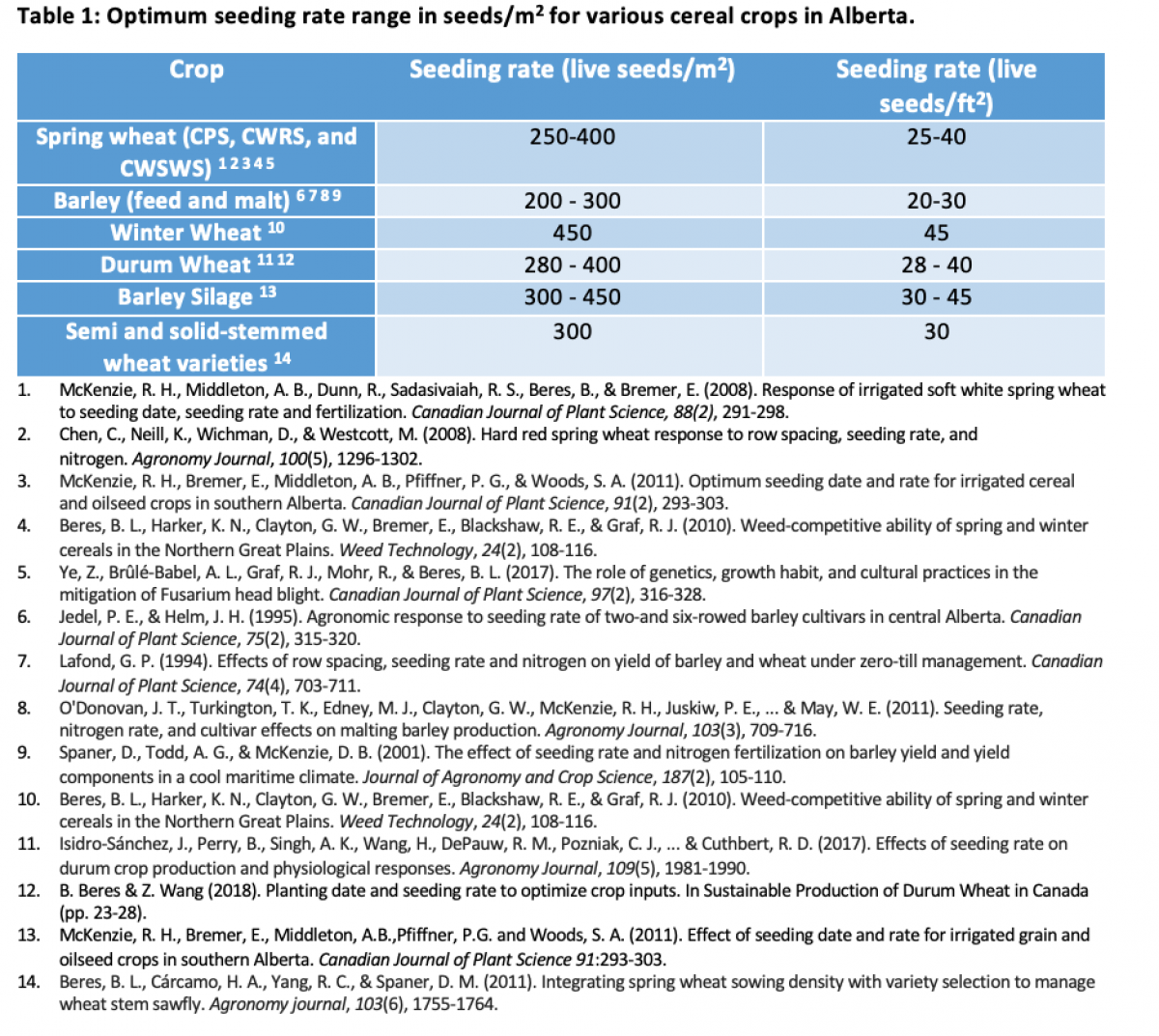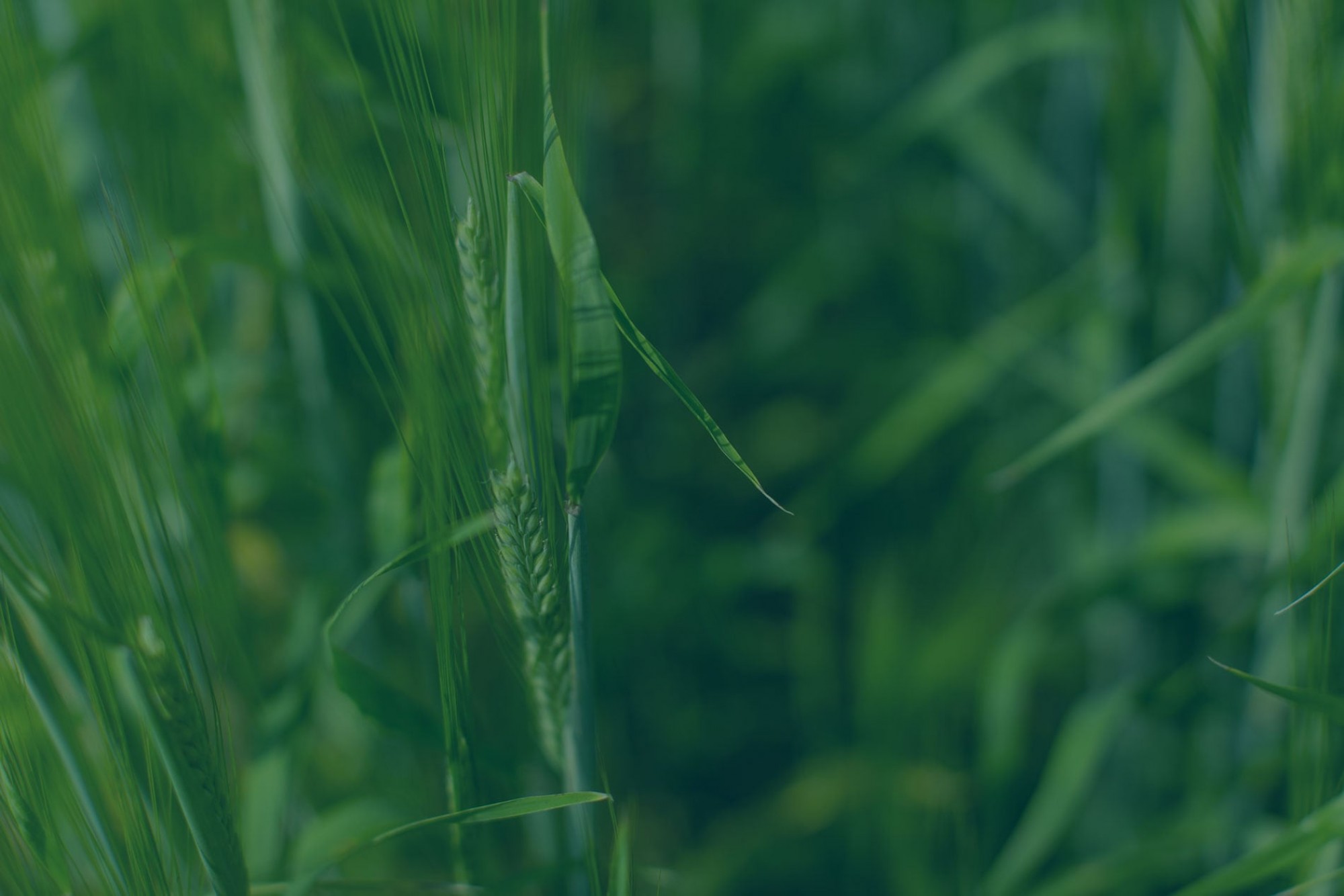Wheat and barley target seeding rates
By Jeremy Boychyn MSc. P.Ag., Agronomy Research Extension Manager | Alberta Wheat and Barley Commissions
Utilize the information below to make informed seeding decisions using our seeding rate calculator.
Seeding Rate CalculatorSowing an accurate amount of a high-quality seed lot is a foundational step in growing a successful wheat or barley crop. Although your final plant stand will be impacted by environmental factors such as moisture, disease, insect pests, soil conditions, seed quality and equipment accuracy, the number of seeds sown will be a fundamental factor in achieving the correct plant stand.
Plant stand is correlated to yield potential. In general, a heavier plant stand increases the yield potential of wheat (Chen et al., 2008, McKenzie et al., 2011 and McKenzie et al., 2008) and barley (O’Donovan et al., 2012 and O’Donovan et al., 2005) until a certain point where additional plants do not provide additional yield. High plant stands also increase crop yield stability (Collier et al., 2021). The plant stand will influence how biotic and abiotic factors impact the crop’s performance.
Weed competition
A field is a growing environment that holds a finite number of resources in the form of nutrients, moisture, sunlight capture and space. At higher plant stands, the wheat or barley crop is able to capture a larger percentage of the available resources. This means there are fewer available resources for weeds to utilize. This may mean increased herbicide efficacy, reduce weed seed banks and reduce weed competition that may impact the crop’s yield potential.
Disease management
Seeding rates will impact the flowering window of wheat and barley. Although the influence may differ for various crop types, high seeding rates will reduce the number of tertiary and late tillers (Beres et al., 2011). A lighter plant stand crop will provide more room for later tillers to occur. These late tillers extend the flowering window of the crop by flowering later than the main tillers. An extended flowering window increases the risk of Fusarium head blight (FHB) infection. For more information on FHB management, see managefhb.ca.
Maturity and harvest
For those farmers growing wheat and barley under a shorter growing season, higher seeding rates can be used to reduce the risk of late-season weather impacts on yield and quality. As mentioned above, lower seeding rates increase the number of late tillers. An increase in late tillers extends the crop’s days to maturity (O’Donovan et al., 2012 and Briggs and Aytenfisu, 1979). Late tillers can cause setbacks in the harvestability of a crop due to a higher grain moisture content. This increases the risk of adverse weather impacting the crop’s quality and harvestability.
Semi and solid-stemmed varieties
Semi and solid-stemmed varieties utilized for wheat stem sawfly management require specific seeding rates. Seeding rates for these varieties must target 300 seeds/m2 to ensure proper pith (solid-stem) expression. Although maximum pith is expressed at lower seeding rates, 300 seeds/m2 provides the best balance of pith expression and yield potential.
Target rates
Table 1 indicates recommended seeding rates for various wheat and barley crops. For each crop, an optimum target seeding rate range is given. The lower end of the optimum range was sufficient to attain maximum yields. However, the higher end of the optimum range provided slight increases in yield, economic return, weed suppression, and aids in crop uniformity. Additionally, it is important to consider seed quality when determining seeding rates. Factors such as thousand kernel weight (TKW) and germination can impact the amount of seed sown.

Literature
Briggs, K. G., and Aytenfisu A. (1979). "The effects of seeding rate, seeding date and location on grain yield, maturity, protein percentage and protein yield of some spring wheats in central Alberta." Canadian Journal of Plant Science 59.4: 1139-1145.
Chen, C., Neill, K., Wichman, D., & Westcott, M. (2008). Hard red spring wheat response to row spacing, seeding rate, and nitrogen. Agronomy Journal, 100(5), 1296-1302.
Collier, G.R.S.; Spaner, D.M.; Graf, R.J.; Beres, B.L. (2021). Optimal Agronomics Increase Grain Yield and Grain Yield Stability of Ultra-Early Wheat Seeding Systems. Agronomy, 11, 240.
McKenzie, R. H., Middleton, A. B., Dunn, R., Sadasivaiah, R. S., Beres, B., & Bremer, E. (2008). Response of irrigated soft white spring wheat to seeding date, seeding rate and fertilization. Canadian Journal of Plant Science, 88(2), 291-298.
McKenzie, R. H., Bremer, E., Middleton, A. B., Pfiffner, P. G., & Woods, S. A. (2011). Optimum seeding date and rate for irrigated cereal and oilseed crops in southern Alberta. Canadian Journal of Plant Science, 91(2), 293-303.
McKenzie, R. H., A. B. Middleton, and E. Bremer. (2005). "Fertilization, seeding date, and seeding rate for malting barley yield and quality in southern Alberta." Canadian Journal of Plant Science 85.3: 603-614.
O’Donovan, J. T., Turkington, T. K., Edney, M. J., Juskiw, P. E., McKenzie, R. H., Harker, K. N., Clayton, G. W., Lafond, G. P., Grant, C. A., Brandt, S., Johnson, E. N., May, W. E. and Smith, E. (2012). Effect of seeding date and seeding rate on malting barley production in western Canada. Canadian Journal of Plant Science. 92: 321-330.

